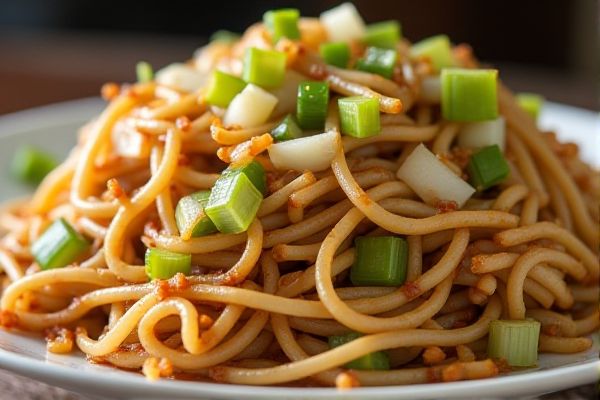
Chow Mein from Panda Express features tender stir-fried noodles mixed with crisp celery, savory cabbage, and flavorful onions, all tossed in a light soy-based sauce, delivering a deliciously satisfying combination of soft and crunchy textures.
Equipments
- Wok
- Wok spatula or wooden spoon
- Cutting board
- Chef's knife
- Mixing bowl
- Measuring spoons
- Colander or strainer
Ingredients
- 12 oz (340g) chow mein noodles or yakisoba noodles
- 2 tablespoons vegetable oil
- 1 medium onion
- 2 stalks celery
- 2 cups napa cabbage or green cabbage
- 3 tablespoons soy sauce
- 1 tablespoon oyster sauce
- 1 tablespoon hoisin sauce
- 1 teaspoon sesame oil
- 1/2 teaspoon sugar
- 1/4 teaspoon white pepper
- 2 cloves garlic
To achieve the authentic flavor of Panda Express Chow Mein, use chow mein or yakisoba noodles, as their texture holds up well during stir-frying. Fresh vegetables such as celery, napa cabbage, and onions are essential to provide the signature crunch and balance to the dish. The key sauces--soy sauce, oyster sauce, hoisin sauce, and a touch of sesame oil--combine to create the light yet flavorful coating for the noodles. Adjust seasoning with sugar and white pepper to replicate the subtle sweetness and spice found in the original recipe. Your homemade Chow Mein from Panda Express copycat menu will deliver the perfect harmony of tender noodles and crisp vegetables.
Instructions
- Instructions:
- Cook chow mein noodles according to package instructions. Drain and set aside.
- Slice onion, celery, and cabbage thinly.
- Mince garlic.
- In a mixing bowl, combine soy sauce, oyster sauce, hoisin sauce, sesame oil, sugar, and white pepper. Mix well to form the sauce.
- Heat 1 tablespoon vegetable oil in a wok over medium-high heat.
- Add sliced onions and celery. Stir-fry for 1-2 minutes until slightly tender.
- Add minced garlic and cabbage. Stir-fry for another 1-2 minutes until fragrant and vegetables are crisp-tender.
- Push vegetables to the side of the wok. Add remaining 1 tablespoon oil and cooked noodles.
- Pour the prepared sauce over the noodles and vegetables.
- Toss everything together until noodles are evenly coated and heated through, about 2-3 minutes.
- Serve immediately.
Substitution
Chow Mein from Panda Express copycat menu replicates the iconic dish with stir-fried noodles, celery, cabbage, onions, and a savory soy-based sauce. If you cannot find chow mein noodles, yakisoba noodles serve as a perfect substitute, as both offer similar texture and taste. Use vegetable oil or any neutral oil like canola or peanut oil for stir-frying to avoid overpowering flavors. When napa cabbage is unavailable, green cabbage works well, providing a slightly different but still delicious crunch. Your cooking process benefits from high heat when using a wok to achieve the ideal stir-fry texture and keep vegetables crisp.
Tips
Ensure you cook the chow mein noodles just until tender and avoid overcooking, as they will continue to cook slightly during stir-frying. When slicing celery, onion, and cabbage, cut them thinly and uniformly for even cooking and balanced texture. Use a well-heated wok to achieve a quick, high-heat stir-fry, which helps maintain the crispness of the vegetables while keeping the noodles soft. Your sauce mixture should be prepared in advance and added at the end to evenly coat the noodles and veggies, ensuring every bite bursts with flavor.
Nutritions
Chow Mein from Panda Express provides a balanced mix of macronutrients, primarily from the stir-fried noodles and vegetable medley. The noodles offer a good source of carbohydrates for energy, while the vegetables--celery, cabbage, and onions--contribute dietary fiber, vitamins like vitamin C and K, and minerals essential for immune support and digestion. The inclusion of soy sauce, oyster sauce, and hoisin sauce adds flavor with minimal calories but contains sodium, so you should monitor intake if managing salt consumption. Your meal delivers both comfort and nutrition by blending soft noodles and crunchy vegetables with a lightly seasoned sauce.
Storage
To store your Panda Express-style Chow Mein, allow the noodles to cool to room temperature before transferring them to an airtight container to preserve freshness and texture. Refrigerate the container promptly, where the chow mein can stay good for up to 3-4 days. When reheating, use a wok or microwave and add a splash of water or soy sauce to maintain moisture and prevent drying out.
Variation or Alternatives
For a variation, try substituting chow mein noodles with thin rice noodles or zucchini noodles to reduce carbs and add a gluten-free option to your meal. You can switch the napa cabbage for bok choy or kale to introduce different nutrient profiles and textures. Incorporate protein such as tofu, chicken, or shrimp by stir-frying them before adding the vegetables, ensuring a well-rounded, savory dish. Your sauce can be customized by adjusting the hoisin and oyster sauce ratio or adding a splash of chili garlic sauce for a spicier kick.
Allergies
Chow Mein from Panda Express contains common allergens such as soy (in soy sauce), shellfish (in oyster sauce), and sesame (in sesame oil), which may trigger reactions in sensitive individuals. The recipe also includes ingredients like garlic and onions that can cause discomfort for those with allium allergies. You should carefully check ingredient labels and consult with a healthcare provider if you have food allergies before consuming this dish.
Why this recipe?
Panda Express Chow Mein features perfectly cooked noodles tossed with fresh cabbage, celery, and onions, delivering a savory and slightly sweet flavor profile that satisfies many taste preferences. The dish balances soft and crunchy textures, making each bite enjoyable and comforting. You can replicate this beloved recipe at home, allowing customization with your preferred protein or vegetables, ensuring a personalized dining experience. Making your own copycat version saves money and offers a chance to experiment with authentic Chinese-American flavors anytime.
